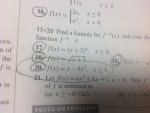You are using an out of date browser. It may not display this or other websites correctly.
You should upgrade or use an alternative browser.
You should upgrade or use an alternative browser.
Inverse function problem!
- Thread starter william91
- Start date
D
Deleted member 4993
Guest
Hey!
I am having problems solving this equation as a function of y, or rather an inverse function. Any help is much appreciated!
Number 20. Find the formula for the inverse function
William Schmidt.View attachment 4473
Hint:
exchange 'x' to 'y' and 'y' to 'x' - then solve for 'y'
What are your thoughts?
Please share your work with us ...
If you are stuck at the beginning tell us and we'll start with the definitions.
You need to read the rules of this forum. Please read the post titled "Read before Posting" at the following URL:
http://www.freemathhelp.com/forum/th...Before-Posting
- Joined
- Feb 4, 2004
- Messages
- 16,583
Where are you stuck in the process? You changed "f(x)" to "y", solved for "x=" (probably using the Quadratic Formula), used the restriction to pick the correct part of the Formula, and... then what?Number 20. Find the formula for the inverse function
\(\displaystyle f(x)\, =\, x\, -\, 5x^2,\, x\, \geq\, 1\)
Please be complete. Thank you!
Process
Thanks guys!
I'm basically at the beginning of the task. I understand what I should do, however, the "how" is more of a mystery to me. I have tried numerous ways, but to no avail.
Why would I use the quadratic formula? I thought the quadratic formula is there to show me when the equation equals zero, why would that be useful?
I have used so much time on this one equation, but I'm just not getting it..


Thanks guys!
I'm basically at the beginning of the task. I understand what I should do, however, the "how" is more of a mystery to me. I have tried numerous ways, but to no avail.
Why would I use the quadratic formula? I thought the quadratic formula is there to show me when the equation equals zero, why would that be useful?
I have used so much time on this one equation, but I'm just not getting it..
HallsofIvy
Elite Member
- Joined
- Jan 27, 2012
- Messages
- 7,763
Your given function is \(\displaystyle y= f(x)= x- 5x^2\) and you have been told that, since the "inverse" function just "reverses" that, that you need to solve \(\displaystyle x= y- 5y^2\) for y. Yes, that is a quadratic equation so the "quadratic formula" would be one way to do it. Have you tried that? You say "I thought the quadratic formula is there to show me when the equation equals zero". Do you not see that \(\displaystyle x= y- 5y^2\) is the same as \(\displaystyle 5y^2- y+ x= 0\)? What do you get with the quadratic formula?
(Do not forget the condition on the original function "x> 1". Do you see what that is important?)
(Do not forget the condition on the original function "x> 1". Do you see what that is important?)
Last edited:
Your given function is \(\displaystyle y= f(x)= x- 5x^2\) and you have been told that, since the "inverse" function just "reverses" that, that you need to solve \(\displaystyle x= y- 5y^2\) for y. Yes, that is a quadratic equation so the "quadratic formula" would be one way to do it. Have you tried that? You say "I thought the quadratic formula is there to show me when the equation equals zero". Do you not see that \(\displaystyle x= y- 5y^2\) is the same as \(\displaystyle 5y^2- y+ x= 0\)? What do you get with the quadratic formula?
(Do not forget the condition on the original function "x> 1". Do you see what that is important?)
Thank you for your response, I really appreciate it.
I see that x=y-5y^2 and 5y^2-y+x=0 is the same. So i put that into the quadratic formula?
I just did, and its like magic! Haha, I have no idea what just happened, but my answer is the same as the solutions manual. Can somebody give me a brief explanation as to what just happened? :O
I'm loving math more and more!
Thank you for your help once again!
HallsofIvy
Elite Member
- Joined
- Jan 27, 2012
- Messages
- 7,763
"Like magic"? You know what the "quadratic formula" is, don't you? You know it gives the values of the variable that make the equation true?
So you know that applying the quadratic equation to \(\displaystyle 5y^2- y+ x= 0\) gives you the values of y that make that equation true, for every value of x. And you were told that, starting form y= f(x), swapping x and y to get x= f(y) and solving for y, getting "y= some other function of x" will give you the inverse function. That "magic" is exactly what you were told would happen.
So you know that applying the quadratic equation to \(\displaystyle 5y^2- y+ x= 0\) gives you the values of y that make that equation true, for every value of x. And you were told that, starting form y= f(x), swapping x and y to get x= f(y) and solving for y, getting "y= some other function of x" will give you the inverse function. That "magic" is exactly what you were told would happen.

